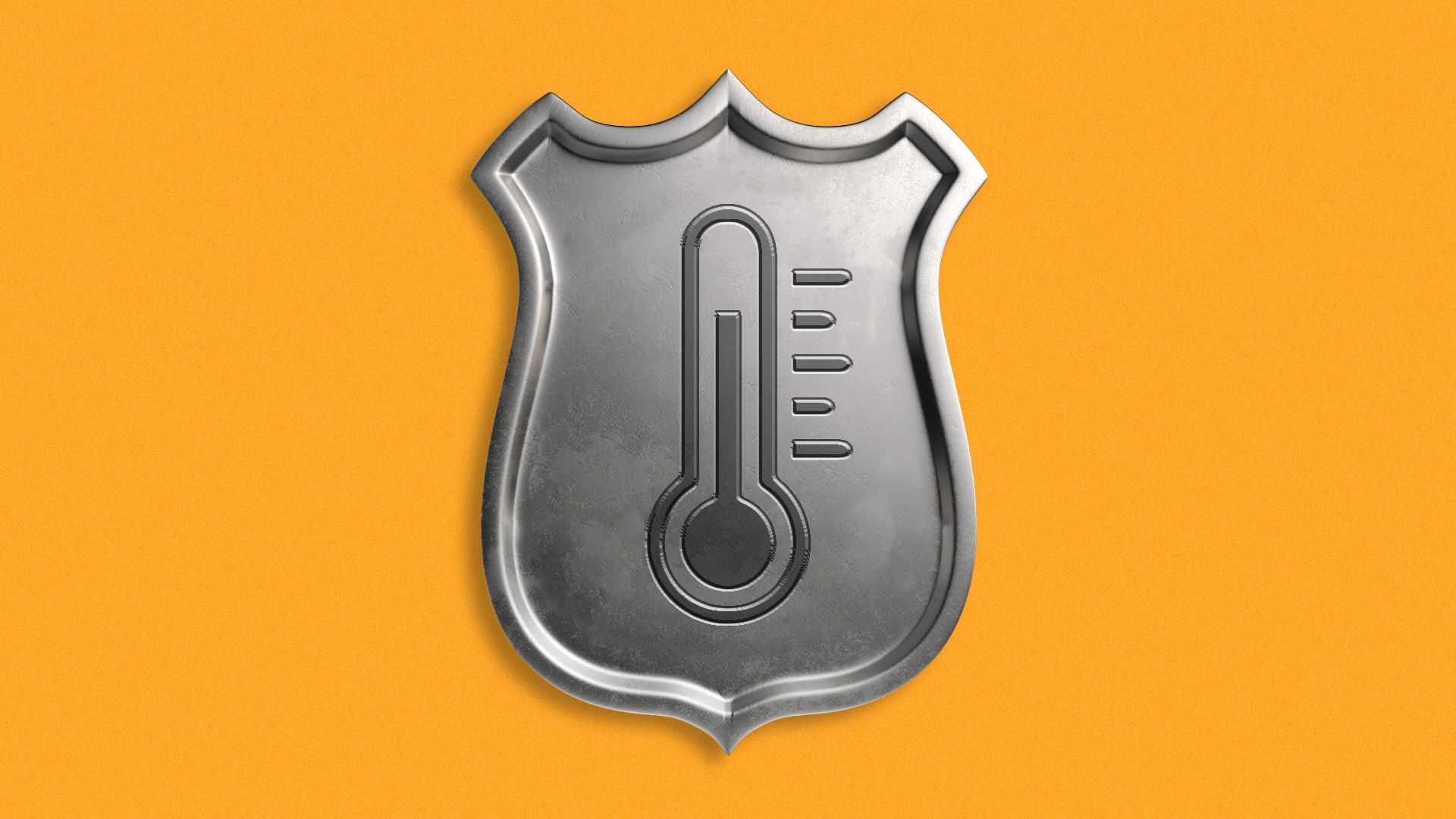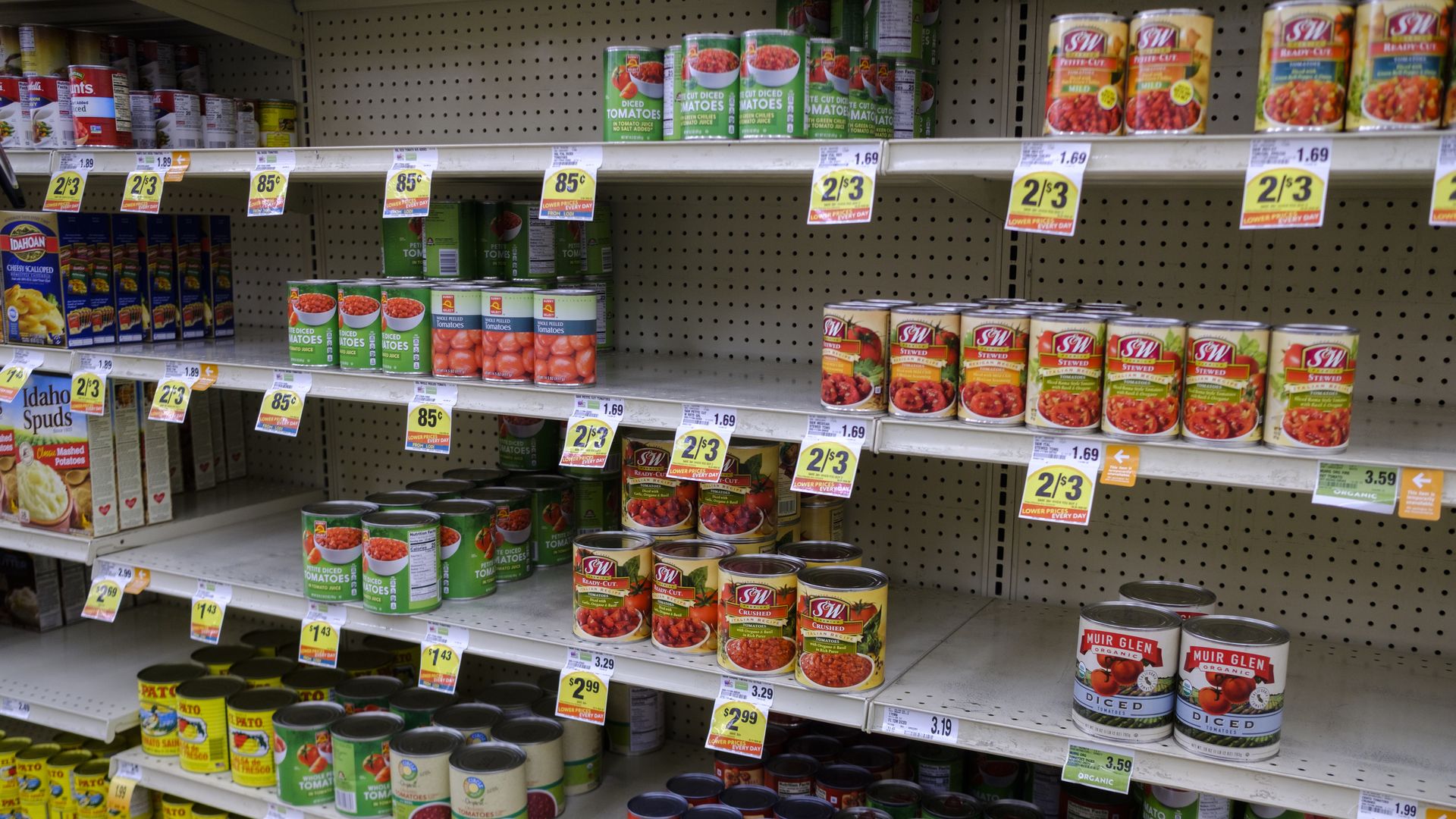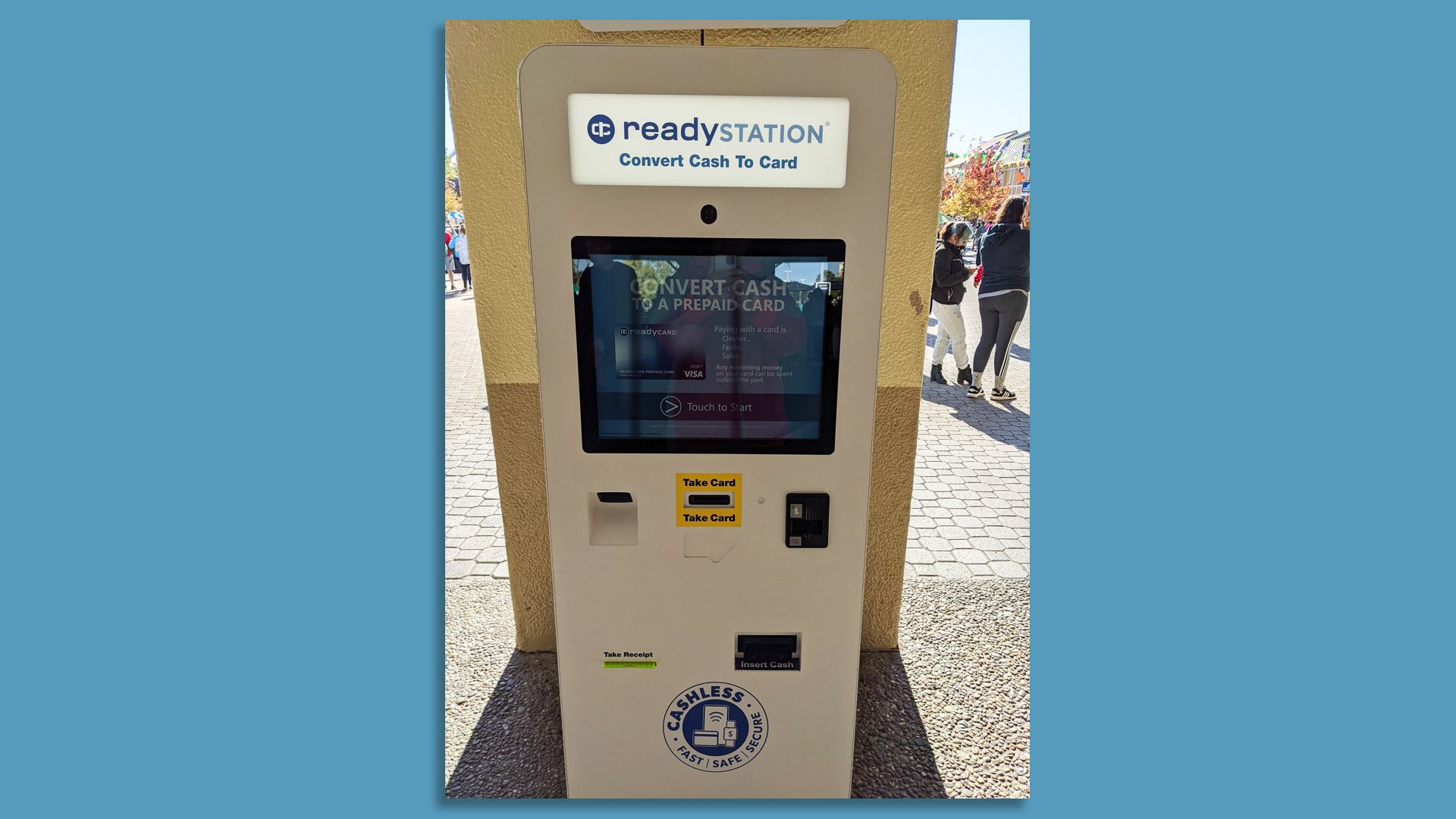| | | | | | | Presented By Prudential | | | | Axios What's Next | | By Jennifer A. Kingson, Joann Muller and Erica Pandey ·Nov 01, 2021 | | As the mellifluously named COP26 climate summit proceeds in Glasgow, Scotland, this week, Jennifer A. Kingson reports on cities like Phoenix and Miami hiring "chief heat officers." - Last week, we asked What's Next readers to tell us what items you're having trouble finding at your local stores — some responses, below.
- Today's reader photo comes from Jack Miskimens; his dad, Jeff, took it at an amusement park.
Today's Smart Brevity count: 1,204 words ... 4.5 minutes. | | | | | | 1 big thing: "Chief heat officer" is an up-and-coming title |  | | | Illustration: Annelise Capossela/Axios | | | | Cities around the world — starting with the ones most imperiled by climate change — are hiring "chief heat officers" to devise cooling strategies and take immediate action, Jennifer writes. Why it matters: Fatal heat waves, wildfires, hurricanes and floods are growing more frequent and deadly, and —to date — few municipalities have dedicated officials or organized structures in place to handle them. Driving the news: Phoenix, which is one of the fastest-warming cities in the country, recently set up an Office of Heat Response and Mitigation and hired an environmental sciences professor from Arizona State University, David Hondula, to lead it. - Phoenix "experienced its hottest summer on record last year, with more than 114 days where the thermometer tipped past 100°," per Architectural Digest.
- "This year, at least 113 deaths in Maricopa County have been attributed to high temperatures, more than double reported in 2020."
- Phoenix's move comes on the heels of Miami-Dade County hiring the first U.S. chief heat officer, Jane Gilbert, who's trying to mitigate temperature inequities between wealthy coastal neighborhoods and inland Black and Latino ones.
Jane Gallego, the mayor of Phoenix, tells Axios that the heat office will be "data driven" and "look at the best possible solutions out there for managing heat." - An example is cool pavement, "where we've applied a coating and found that it can [have] 10 to 12 degrees cooling impact," Gallego said.
Where it stands: The idea that heat can be managed better through city government has been swirling in academic circles for about a decade, and now it's being recognized more broadly, Hondula, Phoenix's chief heat officer, tells Axios. - His priorities include adding tree canopies, reflective roofs and cooling sidewalks — particularly to reduce dangerous nighttime temperatures.
- Another top concern is protecting homeless people and outdoor workers. "We all need to think about emergency services, where do we need to get people out of harm's way?" Hondula tells Axios.
- Hondula says his office has "a dual and equal focus on heat mitigation — the strategies to cool the city and make people more comfortable as they move about it — and heat response strategies to protect people."
The big picture: Athens hired a chief heat officer this summer (when the mercury hit 111 degrees) and the city of Freetown in Sierra Leone recently did the same. What's next: Other cities will follow suit, pronto. "We have gotten a lot of inquiries," Gallego said, including from cities in the Northwest during their heat wave this summer. - Gallego belongs to a bipartisan group called Climate Mayors and will be among the members attending this week's summit in Glasgow, Scotland.
- "Almost every city has a traffic safety person and an air quality person," Gallego says. "We think there might be a day when most cities, particularly those most impacted, have a person looking at heat issues."
Read the full story. |     | | | | | | 2. Pineapple juice, kitty litter: What we can't find in stores |  | | | Sparse shelves at a California supermarket during the era of COVID-19. Photo: Jeremy Hogan/SOPA Images/LightRocket via Getty Images | | | | Last week, we asked you to tell us what items you're missing, most likely because of pandemic-induced supply chain issues. Some of you were quite specific: - Christy Smith says she can't find Ore-Ida crinkle-cut French fries, cat food (prescription and regular) and "a variety of Jimmy Dean breakfast items;" she says she lives near the Nebraska/Iowa border.
- From Iain Abernathy: "Pineapple juice is usually unavailable, large or small size. When the small cans are in stock, I will buy three or four six-packs. Kitty litter is the other hard-to-find item on my list. There's always some there, but the choices are limited."
- Gayle Lynn Falkenthal has had trouble finding house paint, furniture, replacement windows and shutters. "Silly me, I decided like lots of people to completely remodel my house this past year."
Some of you were more philosophical: - Fredrick W. Lee observed: "The 'great stuff shortage,' or the pandemic's last stand, is exposing many Americans' bad habit of excess, or buying more than what is needed. You name the product, and probably the average American has one too many of it."
- And Pat Murphy told us: "Wasn't one of the golden lessons learned in the pandemic that we don't need to keep consuming at the levels that we had previously?"
|     | | | | | | 3. Gangbuster pay jump |  Data: Employment Cost Index, via U.S. Bureau of Labor Statistics; Chart: Axios Visuals America's pay gains just logged a fresh record: Wages and salaries surged at the fastest pace ever last quarter, Courtenay Brown writes in Axios Closer. - The data released Friday is considered a better gauge of wage gains than others because it's not impacted by the drastic workforce shifts we've seen during the pandemic.
The backdrop: Employers are still doling out pay hikes in an attempt to break a labor shortage stalemate. - Costco this week made a last-ditch effort to lure (and keep) workers as the all-important holiday season looms: effective Monday, employees will make a minimum of $17 an hour.
- It's the second pay raise in eight months (Costco upped it to $16 in February).
What to watch: The retail sector's trade group said Wednesday the sector would hire up to 665,000 seasonal workers this season — one sign of the ferocious appetite by employers to keep up with the demand they expect for their goods. - That would be 179,000 more holiday hires than last year, if they can find the people.
One big asterisk: "With prices up 4.4% over the last 12 months, wage increases are barely keeping pace with inflation," economists at Brean Capital wrote Friday. Share this story. |     | | | | | | A message from Prudential | | Prudential is the rock organizations and employees can rely on | | |  | | | | Prudential helps thousands of organizations effectively meet and manage the benefit, investment and retirement needs of employees. Why it's important: Strong benefit plans that work for everyone help employees feel unstoppable and companies enjoy a more productive workforce. Learn more. | | | | | | 4. The cultural factors behind falling fertility rates |  | | | Illustration: Annelise Capossela/Axios | | | | Fertility rates in the U.S. are falling for reasons that go beyond the economic, Bryan Walsh writes in Axios Future. Why it matters: The demographic makeup of a country helps decide its future, but it also alters its present. - A country with fewer young children is one that will likely be culturally less hospitable to parents, which in turn could reinforce declining fertility rates.
By the numbers: 24.6 million Americans are under the age of 6. - That's the same number as in 1962, but whereas in that year, young children made up more than 13% of the population, today they comprise a little more than 7%.
Between the lines: The reasons behind falling fertility rates are many, from delayed or nonexistent marriages to changing life priorities to lack of financial assistance — a factor that won't be helped by the reduced provisions for paid family leave in the latest iteration of President Biden's Build Back Better plan. - But another reason is a changing cultural climate around children in many parts of the U.S.
Read the full story. |     | | | | | | 5. Reader photo of the day |  | | | A kiosk at Kings Island amuseement park in Cincinnati. Photo: Jeff Miskimens | | | | What's Next: Cashless amusement parks Jack Miskimens writes: "My dad sent me this photo when he walked into the Kings Island [amusement park] Halloween Haunt in Cincinnati. "This machine is used to convert your cash and spare change into a prepaid card that can be used throughout the park. If you read the screen, it also says that if you put too much on the card, you can use it outside the park on your next purchases. "Who doesn't remember going to your favorite amusement park and having to worry about cash and spare change while on rides? "Now [the amusement park operator] doesn't have to worry about employees handling cash and differences if an employee gives too little or too much change back. Bookkeeping becomes much more streamlined, and [it's] quicker to get real-time data and results." |     | | | | | | A message from Prudential | | Prudential is the rock organizations and employees can rely on | | |  | | | | Prudential helps thousands of organizations effectively meet and manage the benefit, investment and retirement needs of employees. Why it's important: Strong benefit plans that work for everyone help employees feel unstoppable and companies enjoy a more productive workforce. Learn more. | | | | Are there out-of-stock items in your area that you'd like to flag for us? Do you have a picture you've taken that encapsulates our "What's Next" theme? Write to us at whatsnext@axios.com and ask your friends to sign up for our free newsletter here. (Sure, that's a lot to ask, but hey — we think we're worth it. 😇) |  | | It'll help you deliver employee communications more effectively. | | | | | | Axios thanks our partners for supporting our newsletters. If you're interested in advertising, learn more here.
Sponsorship has no influence on editorial content. Axios, 3100 Clarendon Blvd, Suite 1300, Arlington VA 22201 | | | You received this email because you signed up for newsletters from Axios.
Change your preferences or unsubscribe here. | | | Was this email forwarded to you?
Sign up now to get Axios in your inbox. | | | | Follow Axios on social media:    | | | | | |










No comments:
Post a Comment